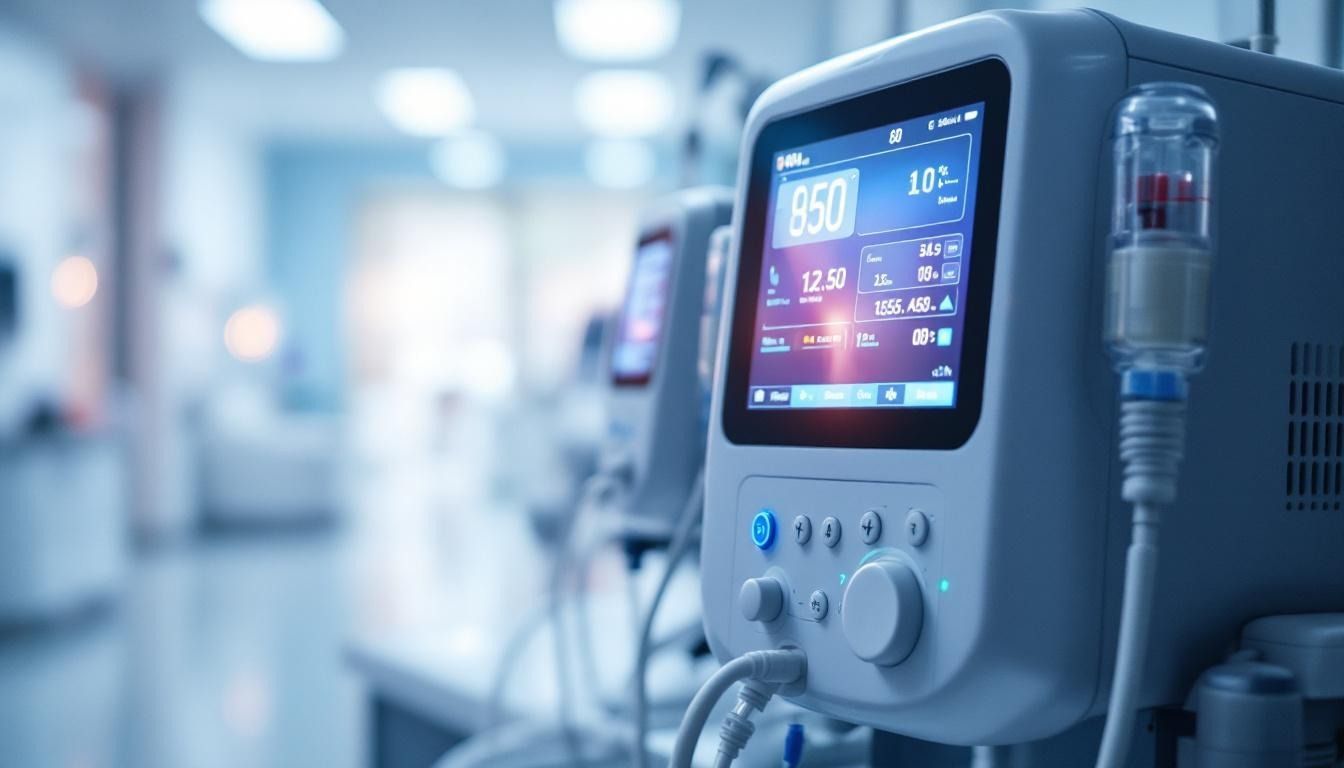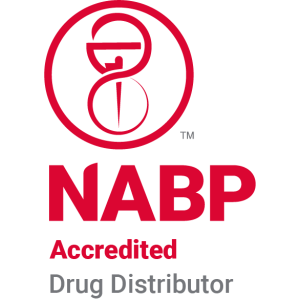Essential Nutrients in TPN Formulations
Understanding the Foundation of TPN Composition
Total Parenteral Nutrition (TPN) is a specialized method of delivering essential nutrients directly into the bloodstream to support patients with impaired gastrointestinal function. Ensuring the precise composition of TPN is critical for patient safety, clinical efficacy, and recovery. This article explores the main components of TPN, their roles, composition guidelines, and the significance of essential nutrients in clinical nutrition.
Main Components of TPN Formulations
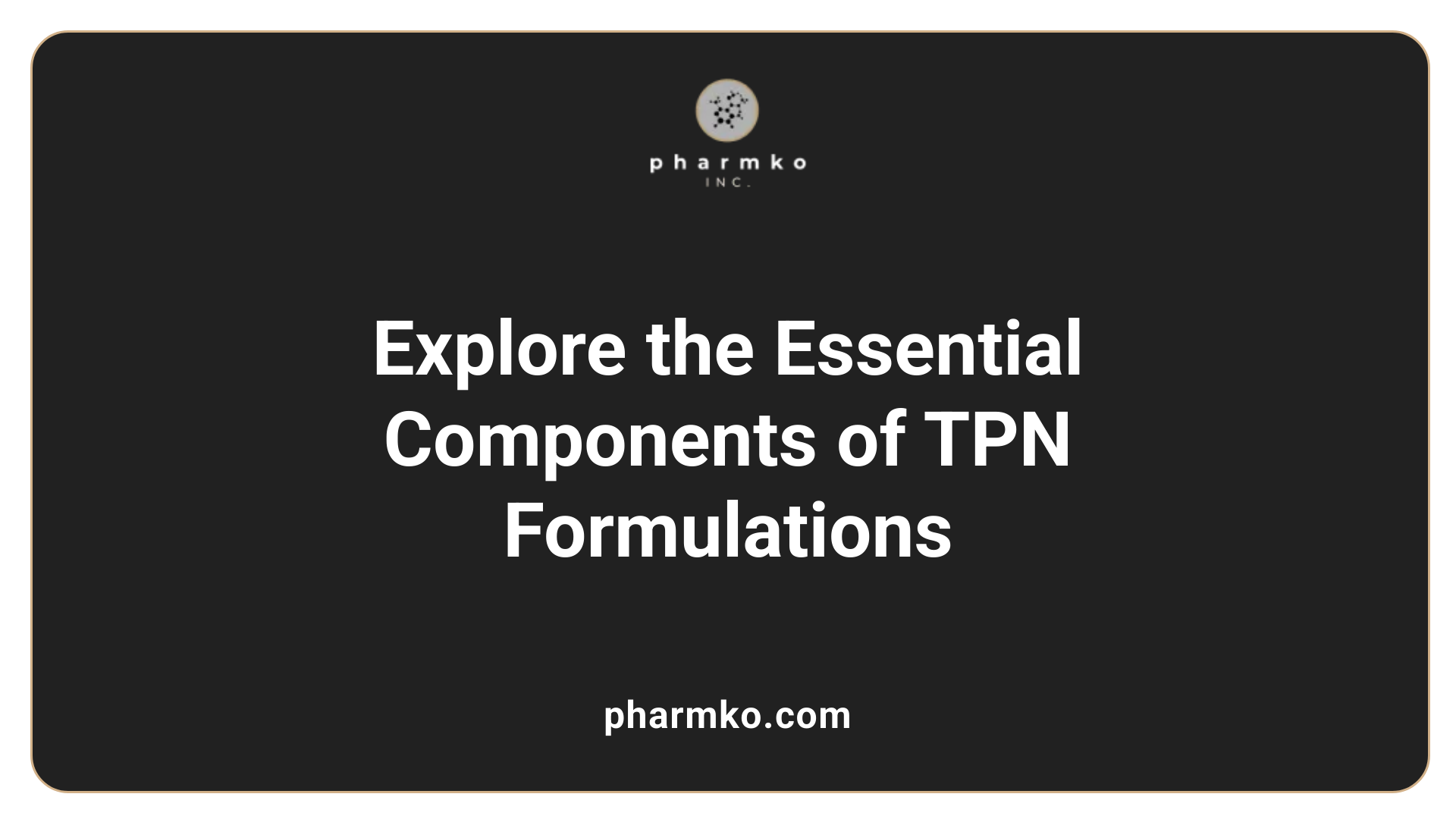
What are the main components of Total Parenteral Nutrition (TPN) formulations?
Total Parenteral Nutrition (TPN) is a complex mixture designed to provide all necessary nutrients directly into the bloodstream for patients who cannot ingest or absorb food through their gastrointestinal tract. The formulation of TPN includes several essential components, each serving specific and vital roles in maintaining the patient’s health.
The core of TPN is water , which acts as the solvent for all other nutrients. Typically, sterile water for injection or bacteriostatic water for injection is used to ensure sterility and proper mixing of the nutrients.
Carbohydrates are primarily supplied via dextrose monohydrate . This serves as the main energy source for the body. The concentration of dextrose in TPN can vary widely, generally from 20% to 70%, depending on the patient’s energy needs. Dextrose provides calories quickly and efficiently, but excess intake can lead to hyperglycemia, so careful regulation is necessary.
Lipids are delivered as fat emulsions , which are essential for cellular structure, hormone synthesis, and absorption of fat-soluble vitamins. Lipid emulsions are typically derived from soybean oil, safflower oil, coconut oil, olive oil, or fish oil. They usually comprise between 10% and 30% of the total calories in TPN. Lipids supply concentrated energy (9 kcal/g) and essential fatty acids, supporting metabolic balance and reducing the workload on carbohydrate metabolism.
Amino acids , which are the building blocks of proteins, are included as amino acid solutions containing essential and non-essential amino acids. The concentration ranges from 2% to 15%. They are crucial for tissue repair, immune function, and maintaining muscle mass. The amount required varies based on individual needs, condition, and metabolic demands.
To sustain proper physiological and biochemical functions, various electrolytes (such as sodium, potassium, chloride, calcium, magnesium, and phosphate) are added at specific concentrations. These help maintain fluid and mineral balance, support nerve and muscle functions, and facilitate cellular reactions.
Vitamins (including vitamin C, B-complex, D, E, and K) and minerals (like zinc, copper, manganese, selenium, and iron) serve as micronutrients in the formulation. They support enzyme functions, antioxidant defenses, blood clotting, bone health, and cellular repair. These are usually supplied in micro-dose admixtures tailored to the patient's needs.
Finally, trace elements such as zinc, copper, and manganese are included at lower concentrations but are essential for enzymatic activities involved in antioxidant defense and metabolic processes.
All these components are carefully compounded in sterile pharmaceutical environments, often customized to meet individual patient requirements, ensuring that the nutritional and metabolic needs are fully supported while minimizing the risk of imbalances or adverse reactions.
In summary, TPN formulations encompass water, carbohydrates in the form of dextrose, lipid emulsions for essential fatty acids and calories, amino acids for tissue repair, electrolytes for fluid and mineral homeostasis, and vitamins, minerals, and trace elements to support vital metabolic functions. These elements are individually adjusted based on comprehensive clinical assessments, laboratory results, and nutritional goals, providing a tailored approach to parenteral nutrition.
Roles and Functions of Essential Nutrients in TPN
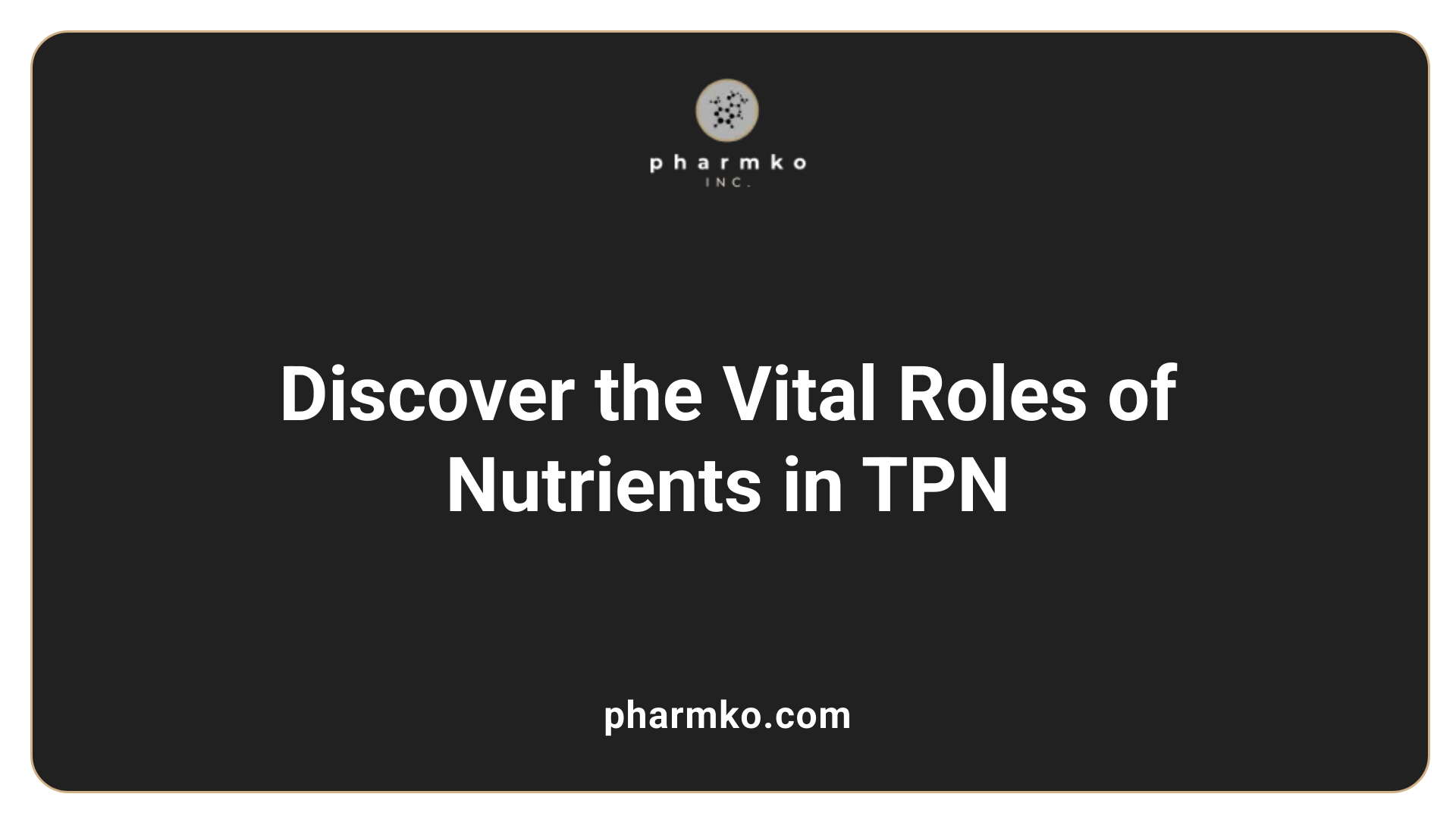
What are the essential nutrients included in TPN and what are their roles?
Total parenteral nutrition (TPN) is formulated to deliver all essential nutrients necessary for survival, growth, and recovery, especially when the gastrointestinal tract cannot be used. These nutrients are carefully balanced to meet individual patient needs, thereby supporting various bodily functions.
Energy provision by dextrose and lipids is foundational in TPN. Dextrose, a form of glucose, serves as the primary carbohydrate source, providing a quick and efficient energy supply. Lipid emulsions, derived from sources like soybean or safflower oil, fulfill their role by offering concentrated calories, essential fatty acids, and aiding in the absorption of fat-soluble vitamins. Lipids typically comprise about 25-40% of TPN calories, ensuring energy needs are met without excessive carbohydrate load.
Tissue repair and immune support from amino acids are crucial for recovery and maintaining health. Amino acids supply both essential and non-essential proteins vital for tissue repair, immune system functioning, and metabolic activities. The requirements vary based on clinical condition but generally range from 2% to 15% of the TPN solution, with critically ill patients requiring higher amounts (up to 1.5 g/kg/day). Proteins aid in wound healing and support cellular regeneration.
Essential fatty acids are critical for maintaining cell membrane integrity and functioning as precursors for hormone synthesis. They include omega-3 and omega-6 fatty acids, which are necessary but cannot be synthesized by the body. Lipid emulsions in TPN supply these fatty acids, which play roles in inflammation modulation and cell signaling.
Vitamins support cellular metabolism, energy production, and antioxidant functions. Vitamins like C, B-complex, K, and E are included in TPN and are vital for enzymatic reactions, blood clotting, immune function, and protecting cells from oxidative stress. Adequate vitamin intake helps prevent deficiency states and supports overall health.
Minerals such as sodium, potassium, calcium, magnesium, and phosphorus help maintain electrolyte balance, support nerve conduction, muscle function, and acid-base regulation. Their precise concentrations are tailored to individual needs, ensuring proper cellular function and hydration status.
Trace elements like zinc, copper, chromium, manganese, and iron are included to support enzymatic reactions. They play roles in collagen synthesis, immune response, oxygen transport, and metabolic processes. For example, zinc is essential for wound healing, while manganese is involved in bone formation.
This comprehensive mixture of macro- and micro-nutrients in TPN is designed to simulate normal nutritional intake while accommodating specific clinical circumstances. Monitoring and adjustments are critical to prevent imbalances, toxicity—such as manganese accumulation—and deficiencies, ensuring optimal patient outcomes.
| Macronutrients | Composition | Main Roles | Sources/Notes |
|---|---|---|---|
| Carbohydrates | Dextrose monohydrate (~20-70%) | Primary energy source, blood glucose regulation | Usually constituting 20-35% of total calories |
| Lipids | Soybean, safflower, fish oils (~25-40%) | Essential fatty acids, concentrated calorie supply | 10-30% of daily energy; sourced as emulsions |
| Proteins | Amino acids (~2-15%) | Tissue repair, immune function, metabolic processes | Requirements vary; 0.8-1 g/kg/day in healthy adults |
| Micronutrients | Vitamins, minerals, trace elements | Support metabolic, enzymatic, and cellular functions | Individually tailored and monitored |
This layered nutrient approach in TPN ensures comprehensive support for patients with impaired GI function, facilitating recovery and maintaining health.
Formulation Standards and Guidelines for TPN

How do clinicians balance macronutrients to meet caloric needs?
In TPN formulations, balancing macronutrients is crucial to ensure patients receive adequate energy without causing metabolic disturbances. Typically, carbohydrates are supplied primarily through dextrose, which forms the bulk of the caloric content, often comprising 20-35 kcal/kg/day depending on the patient's energy expenditure. The concentration of dextrose can vary from 5% up to 70%, but infusion rates are carefully controlled to prevent hyperglycemia.
Lipids are added as emulsions, providing 20-30% of daily caloric needs, and are essential for supplying fatty acids, supporting cellular functions, and minimizing metabolic stress. They are often derived from soybean, safflower, or fish oils, depending on the clinical goal.
Amino acids constitute the remaining caloric requirements and are administered at approximately 1.0-2.0 g/kg/day, adjusted based on patient stress levels. These include essential amino acids necessary for tissue repair, immune function, and wound healing.
Accurate calculation and delivery of these components are essential to satisfy varying metabolic demands, avoid overfeeding, and prevent complications such as fatty liver or hyperglycemia.
Importance of Essential Nutrients for Patient Health

Why are essential nutrients vital for patient health in clinical nutrition?
Essential nutrients play an indispensable role in maintaining overall health and supporting recovery in clinical settings. They are fundamental for numerous bodily functions, including immune responses, tissue repair, and the proper functioning of muscles and nerves. Without adequate intake of these nutrients, patients are at increased risk for deficiencies that can lead to severe health issues.
These nutrients include macronutrients such as carbohydrates, proteins, and fats, as well as micronutrients like vitamins, minerals, and trace elements. Each component contributes uniquely to cellular functions, metabolic processes, and organ health.
For example, proteins supply amino acids necessary for tissue rebuilding and immune cell production. Lipids, especially essential fatty acids, support cellular structure and hormone synthesis. Carbohydrates serve as the primary energy source to power vital functions.
Micronutrients are equally crucial. Vitamins like C and E support immune defenses and act as antioxidants. Minerals such as zinc and copper are vital for enzymatic reactions, while electrolytes like sodium, potassium, and calcium help maintain fluid balance and nerve signal transmission.
In clinical practice, ensuring an adequate supply of these nutrients helps prevent complications related to malnutrition, such as delayed wound healing, susceptibility to infections, muscle weakness, and neurological deficits. Proper nutritional support enhances the body’s ability to recover from illness or surgery and reduces morbidity.
Furthermore, tailored nutrition plans considering individual patient needs—age, disease state, metabolic demands—are essential. For instance, critically ill patients may require higher protein intake to support immune function and tissue repair, whereas patients with metabolic disorders need carefully balanced nutrient amounts.
Neglecting proper nutrition can impair gene expression, hinder cellular repair mechanisms, and exacerbate underlying health problems. Nutritional deficiencies tend to be more prevalent among hospitalized or frail patients, making assessment and administration of essential nutrients a core component of quality healthcare.
In conclusion, adequate and balanced intake of essential nutrients is vital for supporting immune competence, wound healing, muscle and nerve function, and overall vitality. It not only prevents deficiencies and metabolic disturbances but also promotes faster recovery, reduces complications, and enhances the quality of life for patients.
Nutritional Requirements and Formulation Guidelines
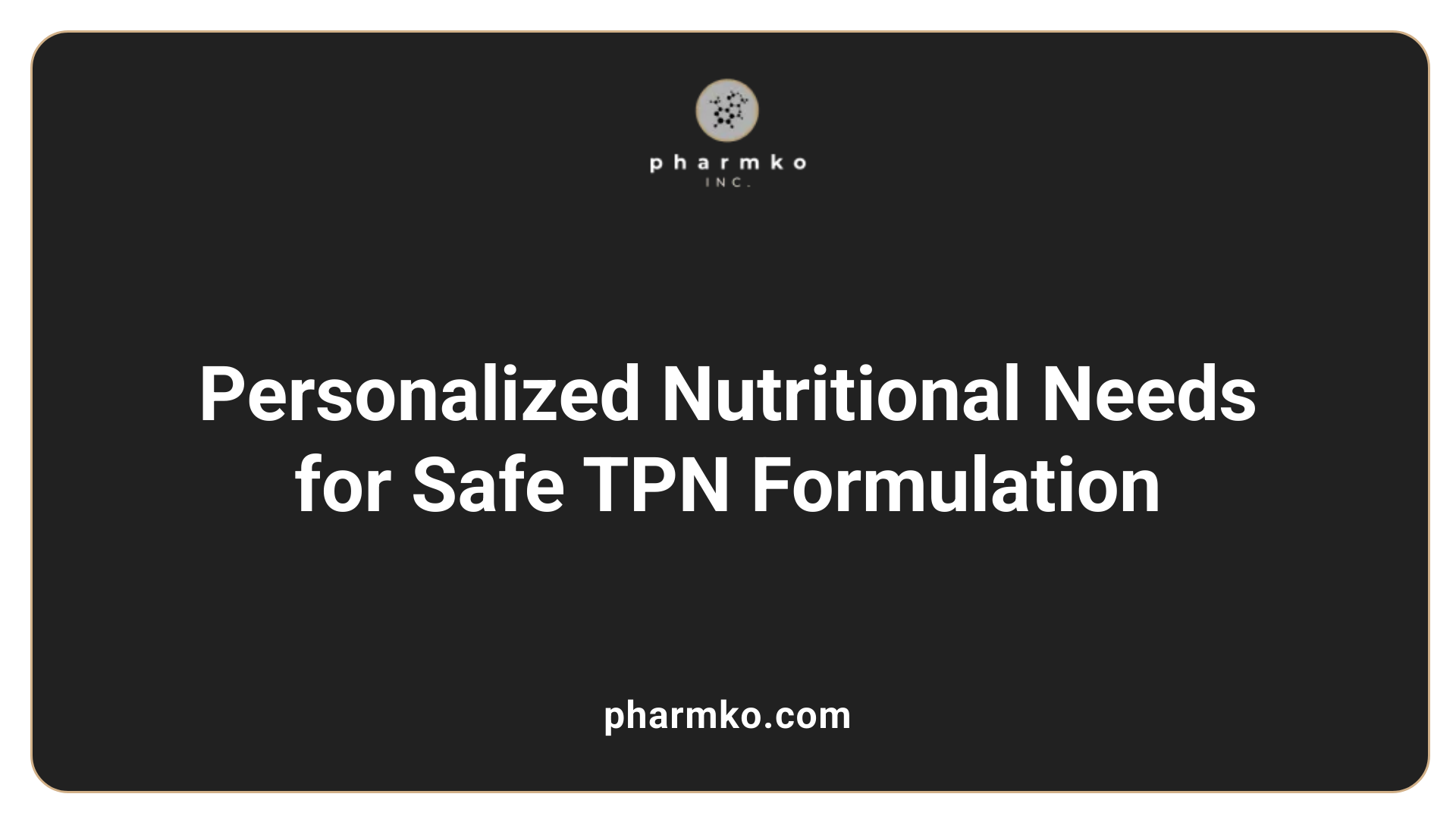
What are the nutritional requirements and guidelines for formulating TPN?
The process of formulating Total Parenteral Nutrition (TPN) is highly patient-specific, relying on individual assessments to determine precise needs. Healthcare professionals consider factors such as age, body weight, medical condition, metabolic rate, and activity level. This personalized approach ensures the delivery of adequate nutrients to meet the patient’s unique metabolic demands.
Typically, TPN includes three main macronutrients:
- Carbohydrates: Delivered mainly as dextrose monohydrate, providing approximately 50-60% of total caloric intake. The concentration varies based on energy needs but often ranges from 20% to 70% in the solution.
- Lipids: Lipid emulsions supply essential fatty acids and serve as a dense energy source, contributing about 25-30% of total calories. They are derived from sources like soybean, safflower, or fish oils, influencing inflammatory responses.
- Amino acids: Providing essential and non-essential amino acids, usually at 1.0–2.0 g/kg/day. Critical illness or hypercatabolic states may require higher amounts up to 2.0 g/kg/day to support tissue repair and immune function.
In addition to macronutrients, micronutrients such as vitamins, trace elements, and electrolytes are incorporated. These are carefully adjusted based on laboratory results and ongoing patient needs.
The total daily caloric intake generally ranges from 25 to 35 kcal/kg/day for healthy adults. Critically ill or hypermetabolic patients might need 30-45 kcal/kg/day to prevent catabolism.
Electrolyte requirements—such as sodium, potassium, magnesium, calcium, phosphate, and chloride—are tailored based on lab monitoring and losses, ensuring cellular function and fluid balance.
TPN solutions are compounded under strict sterile conditions, ensuring stability and compatibility. The chosen administration route (central or peripheral vein) depends on the osmolarity of the solution, with central lines used for more concentrated solutions.
Monitoring is essential for safety and effectiveness. Regular blood tests track glucose levels, electrolyte balance, liver and kidney functions, and signs of toxicity. Adjustments to the formulation are made accordingly to optimize nutritional status and minimize complications.
In summary, guidelines from clinical nutrition societies emphasize meticulous assessment, individualized nutrient formulation, and vigilant monitoring. This approach ensures that each patient’s nutritional therapy effectively supports recovery, growth, and overall health while reducing risks associated with parenteral nutrition.
Role of Micronutrients in TPN
What micronutrients are routinely added to TPN?
Micronutrients are vital components of total parenteral nutrition (TPN), ensuring that patients receive all necessary nutrients for optimal health and recovery. The nutrients typically included are trace elements such as zinc, copper, chromium, manganese, and iron. These are essential for numerous enzymatic activities and metabolic processes in the body.
In addition to trace elements, a range of vitamins is incorporated into TPN formulas. These include the B-complex vitamins, vitamin C, vitamin D, vitamin E, and vitamin K. Each vitamin plays a crucial role, from supporting immune function and wound healing to antioxidant activity and blood clotting.
Electrolytes, which are technically micro-nutrients, such as sodium, potassium, chloride, magnesium, and calcium, are also added to maintain proper fluid and electrolyte balance. These help prevent complications like dehydration or electrolyte imbalances.
The exact composition of micronutrients varies based on individual patient needs, clinical protocols, and regional guidelines. Tailoring the micronutrient profile helps avoid deficiencies and prevents toxicities during long-term TPN therapy.
Why are micronutrients so important in TPN?
Patients who rely on TPN are often critically ill, malnourished, or have gastrointestinal issues that prevent proper absorption of nutrients. Without adequate micronutrients, they risk development of deficiencies that can impair immunity, delay wound healing, or cause organ dysfunction.
Conversely, excessive intake of certain trace elements and vitamins can lead to toxicities. For example, manganese toxicity can affect the brain's basal ganglia, leading to neurological symptoms. Therefore, regular monitoring and adjustment of micronutrient levels are crucial.
How are micronutrient levels monitored and adjusted?
Monitoring involves regular blood tests to assess levels of electrolytes, trace elements, and vitamin status. These results guide clinicians in adjusting the composition of TPN solutions to meet evolving patient needs.
In practice, healthcare providers watch for signs of deficiencies, such as poor wound healing or immune suppression, and for toxicities, like neurotoxicity from manganese or hepatic abnormalities from excessive vitamin A. Adjustments aim to maintain optimal nutritional balance while preventing complications.
Importance of personalized micronutrient inclusion
In clinical settings, the inclusion of specific vitamins and trace elements is individualized. Patients with renal failure may require modified levels of potassium and magnesium, while those with liver disease might need adjustments in vitamin A or copper. For long-term TPN, adjustments are regularly necessary to keep the micronutrient levels within safe and effective ranges.
In summary, micronutrients in TPN are essential for supporting metabolic processes, immune function, growth, and tissue repair. They must be carefully selected, dosed, and monitored to avoid deficiencies and toxicities, ensuring safe and effective nutritional therapy.
Safety and Monitoring in TPN Administration
What laboratory tests are essential for monitoring TPN therapy?
Regular laboratory testing is crucial to ensure the safety and effectiveness of TPN therapy. Key tests include measurements of electrolytes such as sodium, potassium, calcium, magnesium, and phosphate to maintain proper cellular and metabolic function. Blood glucose levels are monitored to prevent hyperglycemia, especially since dextrose is a significant component of TPN. Liver function tests are also essential because long-term TPN can impact hepatic health, potentially leading to cholestasis or steatosis. Additionally, triglyceride levels should be checked when lipid emulsions are administered to monitor for hypertriglyceridemia, which could indicate overload or intolerance to fats.
How is infection and catheter-related issue monitored?
Patients on TPN are at risk for bloodstream infections and catheter-related complications. Vigilant observation for signs of infection—including fever, chills, redness, swelling, or pus at the catheter site—is vital. Regular assessment of the insertion site helps detect early signs of local infection or thrombosis. Proper catheter care protocols and sterile techniques during administration significantly reduce these risks. Monitoring includes frequent checks for patency and functionality of the vascular access device.
How should formulations be adjusted based on lab results?
Adjustments in TPN formulation are dictated by lab results. For example, abnormal glucose levels require modification of carbohydrate concentration to avoid hyperglycemia or hypoglycemia. Electrolyte imbalances may necessitate the addition or reduction of specific minerals or vitamins. Liver enzyme elevations might lead to reevaluation of lipid sources or overall composition. Sodium or fluid shifts detected via labs further inform adjustments to fluid volumes and electrolyte supplementation. Tailoring the TPN solution to current metabolic needs helps prevent deficiencies or toxicities.
What are the risks associated with TPN, such as hyperglycemia and electrolyte imbalance?
Several risks are inherent in TPN therapy. Hyperglycemia can occur if glucose infusion exceeds the patient’s metabolic capacity, leading to hyperosmolar states and requiring insulin adjustments. Electrolyte imbalances, whether hypo- or hyperkalemia or hypocalcemia, can cause severe cardiac or neuromuscular disturbances. Infection risks, particularly catheter-related bloodstream infections, pose a serious threat, potentially leading to sepsis. Long-term, uncorrected nutritional imbalances may cause liver dysfunction, gallbladder problems, and bone demineralization. Routine monitoring and prompt intervention are essential to managing these risks.
Long-term Implications and Potential Risks of TPN
Why are essential nutrients vital for patient health in clinical nutrition?
Essential nutrients are fundamental for maintaining overall health and supporting vital bodily functions. They play critical roles in immune response, tissue repair, nerve and muscle functioning, and metabolic regulation. Adequate intake prevents deficiencies that can cause severe health issues like impaired wound healing, weakened immunity, neurological deficits, and metabolic disturbances.
In clinical settings, especially among patients reliant on Total Parenteral Nutrition (TPN), ensuring proper nutrient balance is crucial. Malnutrition or nutrient imbalances can impair immune defenses, prolong recovery times, and elevate the risk of complications such as infections or organ dysfunction. Properly formulated TPN solutions provide a precise combination of macronutrients—carbohydrates, proteins, and fats—and micronutrients—including vitamins, minerals, electrolytes, and trace elements—to meet individual needs.
Monitoring and adjusting these components help maintain metabolic homeostasis and prevent adverse effects. Adequate nutritional support is essential for promoting healing, supporting growth, and sustaining bodily functions, especially in vulnerable, critically ill, or long-term patients. In essence, managing essential nutrients effectively is a cornerstone of optimal clinical care, directly impacting patient outcomes and quality of life.
Risks of manganese toxicity and neurological effects
Prolonged use of TPN can lead to excessive accumulation of trace elements like manganese. Manganese toxicity particularly affects the basal ganglia in the brain, leading to neurological symptoms known as extrapyramidal symptoms. These may include tremors, dystonia, or Parkinsonian-like features. Since the body’s natural mechanisms for manganese excretion are limited, especially in patients with compromised liver function, excessive doses can be problematic.
Regular monitoring of trace element levels is necessary to prevent toxicity. Adjusting the quantity infused or switching to alternative formulations can mitigate these risks. Recognizing early signs of neurological impairment allows prompt intervention to prevent long-term sequelae.
Hepatobiliary and bone disease with prolonged TPN use
Long-term TPN therapy has been associated with liver complications such as steatosis, cholestasis, and fibrosis. These conditions result from the metabolic burden imposed by high nutrient loads, particularly excess glucose and lipids, and can progress to hepatic dysfunction.
Additionally, extended TPN use may cause bone demineralization. This occurs due to vitamin D deficiency, inadequate calcium supplementation, or metabolic disturbances, increasing the risk for osteopenia and osteoporosis.
Preventing such complications involves careful nutrient tailoring, regular liver function monitoring, and supplementation of key micronutrients like vitamin D and minerals. Transitioning to enteral or oral nutrition as early as feasible can also reduce long-term risks.
Importance of careful nutrient balance and monitoring
Achieving a precise balance of nutrients in TPN is critical for safe and effective therapy. Overfeeding, particularly excess glucose and lipids, can lead to metabolic syndrome, hyperglycemia, hypertriglyceridemia, and liver dysfunction.
Conversely, underfeeding or nutrient deficiencies impair immune function, delay tissue repair, and hinder recovery. Therefore, ongoing assessment through laboratory tests—such as blood glucose, electrolytes, liver function tests, and micronutrient levels—is essential.
Adjustments based on these findings optimize patient outcomes and minimize complications. Collaboration among healthcare providers ensures that each patient’s unique needs are met with individualized nutrient formulations.
Transition strategies from TPN to oral or enteral feeding
Transitioning from TPN to oral or enteral feeding requires a gradual and carefully planned approach. The goal is to stimulate gut function while preventing metabolic disturbances such as hypoglycemia or refeeding syndrome.
The process typically begins with introducing clear liquids, advancing to soft diets, and eventually full enteral feeding as tolerated. Close monitoring of electrolytes, blood glucose, and hydration status guides the pace of transition.
In some cases, a combined approach using both enteral and parenteral nutrition can be maintained until the patient’s nutritional intake becomes adequate.
Ongoing nutritional management post-TPN
Once TPN is discontinued, continued nutritional assessment and support remain vital. Patients may require ongoing supplementation of micronutrients or specific dietary adjustments to address deficiencies or meet increasing activity and recovery needs.
Follow-up includes regular clinical evaluations, laboratory testing, and dietetic consultations to ensure nutritional adequacy. Education on maintaining balanced diet and recognizing deficiencies also supports long-term health.
| Aspect | Consideration | Purpose |
|---|---|---|
| Essential nutrient role | Immune, tissue, neural, metabolic functions | Support healing and overall health |
| Manganese risks | Neurological effects such as tremors, extrapyramidal symptoms | Prevent toxicity via monitoring |
| Hepatobiliary/bone disease | Liver fibrosis, osteoporosis | Minimize through tailored nutrition |
| Nutrient balance | Avoid over/underfeeding | Ensure safety and effectiveness |
| Transition to oral | Gradual steps from liquids to solids | Prevent metabolic imbalance |
| Post-TPN support | Continued micronutrient monitoring | Sustain health and recovery |
Understanding long-term implications of TPN use emphasizes the importance of diligent nutrient management, regular monitoring, and timely adjustments. These strategies help mitigate risks like manganese toxicity, liver complications, and bone disease, ultimately supporting patients' health during and after nutritional therapy.
Summarizing the Significance of Essential Nutrients in TPN
Effective formulation and administration of TPN depend on understanding and optimizing the essential nutrients it contains. These nutrients—macronutrients like carbohydrates, lipids, and amino acids, along with micronutrients such as vitamins, minerals, and trace elements—are fundamental to supporting immune function, tissue repair, metabolic balance, and overall health. Careful monitoring, individualized adjustments, and adherence to clinical guidelines ensure the safety and efficacy of TPN therapy. By maintaining a precise balance of nutrients, healthcare providers can significantly improve patient outcomes, prevent complications, and promote recovery in individuals unable to meet their nutritional needs via the gastrointestinal tract. Knowledge of these essential nutrients is vital for clinicians to deliver optimal clinical nutrition and enhance quality of care.
References
- Total Parenteral Nutrition - StatPearls - NCBI Bookshelf
- What is in a TPN Solution? - AmeriPharma® Specialty Care
- Parenteral Nutrition: What it Is, Uses & Types - Cleveland Clinic
- Parenteral Nutrition Overview - PMC - PubMed Central
- Parenteral Nutrition Formulation - BAPEN
- The Science Behind Total Parenteral Nutrition
- Home Total Parenteral Nutrition (Home TPN) - Nutrishare
- What is Total Parenteral Nutrition (TPN)?
- Parenteral nutrition - Wikipedia







